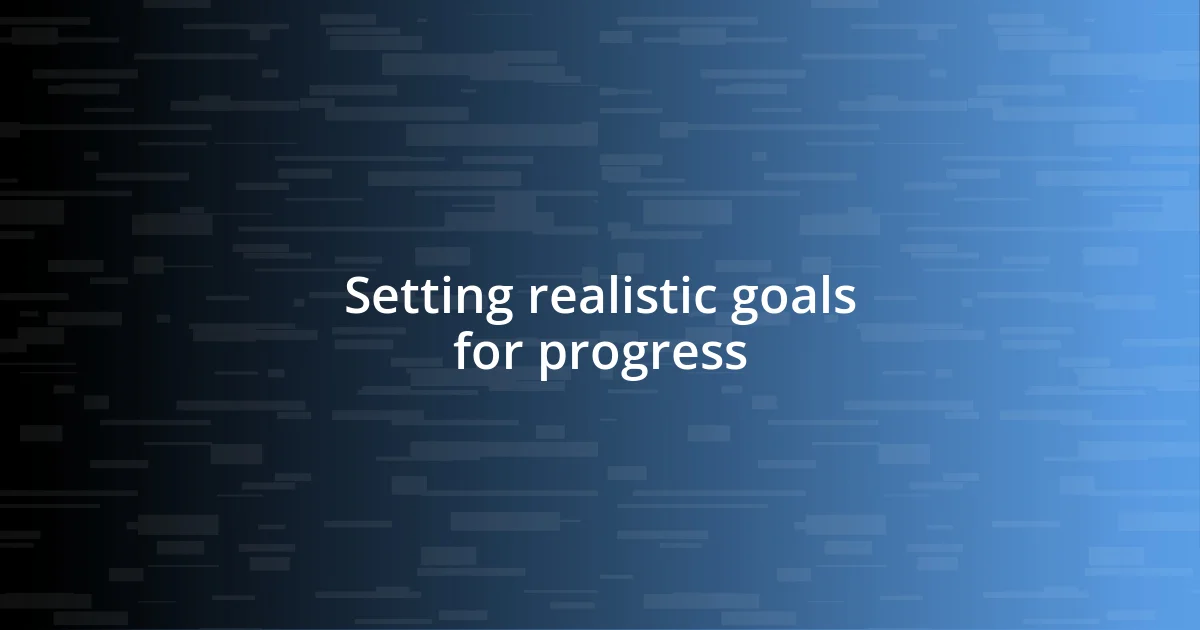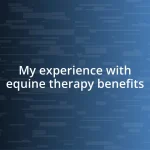Key takeaways:
- Anxiety creates isolation and hinders daily functioning, making it essential to recognize its impact for healing.
- Building a connection with horses fosters trust and emotional communication, providing solace and catharsis.
- Setting realistic goals and creating a supportive riding environment are crucial for managing anxiety and fostering progress.

Understanding anxiety and its impact
Anxiety can often feel like an invisible weight pressing down on us, affecting not only our mental state but also our physical health. I remember those moments when my heart raced, and my mind seemed like a battlefield; it was exhausting. How does it feel to constantly wrestle with thoughts that never seem to quiet down? It can drain your energy and shake your confidence to the core.
One defining aspect of anxiety is its tendency to isolate us. I often found myself withdrawing from friends and activities I once loved, fearing judgment or misunderstanding. Has this ever happened to you? You’re trying to articulate what you’re feeling, but the words just don’t come. This isolation can compound the anxiety, creating a cycle that’s hard to break, and it makes the journey toward healing feel even more daunting.
While many people might dismiss anxiety as just stress or nerves, it’s crucial to acknowledge that it can hinder daily functioning. In my own experience, simple tasks like speaking up in a meeting or ordering a coffee became monumental challenges. This struggle leaves you wondering—what would life be like without that relentless grip of anxiety? Recognizing its impact is the first step toward reclaiming control and finding healthier coping mechanisms.

Building a connection with horses
Establishing a connection with horses is an experience that transcends mere interaction; it’s a dance of trust and understanding. I vividly recall the first time I stood in a paddock, feeling the gentle warmth of my horse’s breath. It’s as though in that moment, any tension I held began to dissipate. Horses are incredibly intuitive beings—they sense your emotions. Have you ever noticed how they mirror your feelings? Their calmness can soften the grips of anxiety, creating a safe space where I found solace.
Building this bond takes patience, much like understanding your own emotions. I learned to approach my horse not just as an animal but as a companion who reflected my state of mind. It was fascinating to see how, when I calmed myself, my horse responded in kind. This mutual understanding wasn’t immediate; it grew over time, a process marked by small victories, like a soft nuzzle or a cooperative trot. Each interaction became a lesson in presence—a gentle reminder that I was not alone in my journey.
Ultimately, the relationship I forged was not only about riding; it was about connection. I found myself talking to my horse as if they understood every word, pouring out anxiety and fears I otherwise struggled to voice. In that exchange, I discovered a powerful method of catharsis. Have you ever felt a weight lift after sharing a burden? For me, this bond became my refuge, where vulnerability met unwavering companionship, proving that sometimes the best way to heal is through the gentle touch of another being.
| Connection Aspect | Personal Experience |
|---|---|
| Intuition | Horses sense my anxiety, reflecting my emotions back to me. |
| Patience | Building trust with my horse took time, enhancing my emotional understanding. |
| Communication | Talking to my horse helped me express feelings I struggled to voice. |

Setting realistic goals for progress
Setting realistic goals was a game changer in my journey to overcome anxiety through riding. Initially, I aimed high—like mastering a challenging jumping course. However, in hindsight, I realized that such lofty aspirations only intensified my stress. Instead, I learned the importance of breaking down those goals into smaller, achievable steps, which made the process feel less overwhelming. When I decided to focus on simple tasks, like improving my posting trot or practicing transitions, I felt a sense of accomplishment that built my confidence and inspired me to keep going.
Here are some practical tips for setting realistic goals in your riding journey:
- Start Small: Begin with basic skills that you feel comfortable with and gradually increase the complexity.
- Be Specific: Instead of saying you want to “get better,” define what “better” looks like—like riding without stirrups for five minutes.
- Celebrate Progress: Acknowledge even minor achievements, whether it’s a successful ride or a new understanding of your horse’s behavior.
- Reflect Regularly: Check in with yourself to see how your anxiety responds to your riding goals and adjust them if necessary.
- Incorporate Rest: Recognize when to take a step back. Low-pressure days can rejuvenate your enthusiasm and keep your anxiety at bay.
Each step forward, no matter how small, became a victory in my personal battle against anxiety. I recall a day when my goal was just to stay on my horse without feeling that familiar knot in my stomach. Accomplishing that simple task felt monumental. It’s these small, genuine victories that laid the foundation for greater strides in my progress and fostered a deeper connection with my riding journey.

Creating a supportive riding environment
Creating a supportive riding environment means surrounding yourself with people who understand your journey. I remember the first time I joined a riding group. They welcomed me with open arms. It felt like stepping into a world where everyone shared their struggles, and I wasn’t alone. Have you ever found solace in a community that just gets you? This camaraderie helped me feel safe, allowing me to express my anxiety without shame.
I also discovered that the physical environment plays a crucial role in fostering comfort. The moment I found a calm, serene stable with gentle horses, I felt my anxiety ease. I recall just standing there, taking deep breaths, and letting the peaceful surroundings wash over me. The soft sounds of hooves on the ground and the occasional whinny became my meditation. Isn’t it amazing how a tranquil setting can shift our mindset so profoundly? Choosing a riding space that promotes relaxation transformed my experience.
Lastly, communication with instructors and fellow riders is vital. When I first opened up about my anxiety with my riding coach, her empathetic response was a game changer. She adjusted my lessons to suit my pace, which made me feel respected and valued. Can you picture the weight lifting off your shoulders when your voice is heard? This personalized support created an environment vastly different from the rigid experience I’d expected. It empowered me to take risks and grow, solidifying my belief that a supportive riding environment is key to overcoming anxiety.














